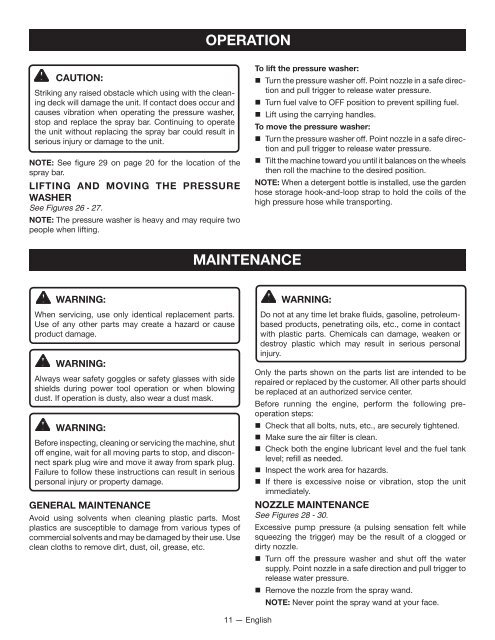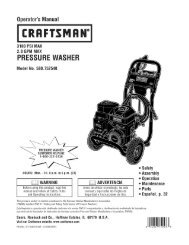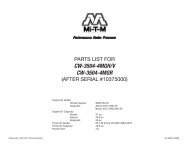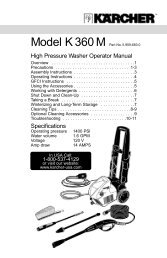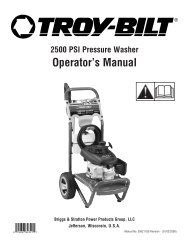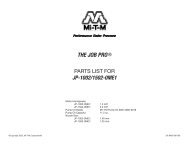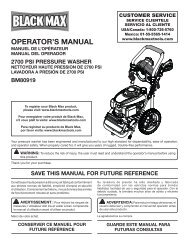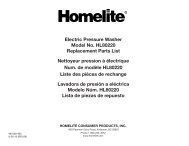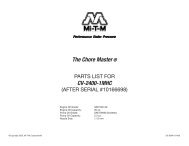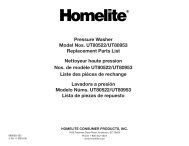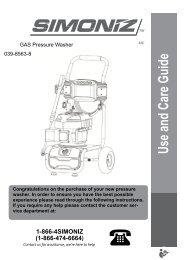OPERATOR'S MANUAL - Ppe-pressure-washer-parts.com
OPERATOR'S MANUAL - Ppe-pressure-washer-parts.com
OPERATOR'S MANUAL - Ppe-pressure-washer-parts.com
You also want an ePaper? Increase the reach of your titles
YUMPU automatically turns print PDFs into web optimized ePapers that Google loves.
Operation<br />
CAUTION:<br />
Striking any raised obstacle which using with the cleaning<br />
deck will damage the unit. If contact does occur and<br />
causes vibration when operating the <strong>pressure</strong> <strong>washer</strong>,<br />
stop and replace the spray bar. Continuing to operate<br />
the unit without replacing the spray bar could result in<br />
serious injury or damage to the unit.<br />
NOTE: See figure 29 on page 20 for the location of the<br />
spray bar.<br />
lifting and moving the <strong>pressure</strong><br />
<strong>washer</strong><br />
See Figures 26 - 27.<br />
NOTE: The <strong>pressure</strong> <strong>washer</strong> is heavy and may require two<br />
people when lifting.<br />
To lift the <strong>pressure</strong> <strong>washer</strong>:<br />
n Turn the <strong>pressure</strong> <strong>washer</strong> off. Point nozzle in a safe direction<br />
and pull trigger to release water <strong>pressure</strong>.<br />
n Turn fuel valve to OFF position to prevent spilling fuel.<br />
n Lift using the carrying handles.<br />
To move the <strong>pressure</strong> <strong>washer</strong>:<br />
n Turn the <strong>pressure</strong> <strong>washer</strong> off. Point nozzle in a safe direction<br />
and pull trigger to release water <strong>pressure</strong>.<br />
n Tilt the machine toward you until it balances on the wheels<br />
then roll the machine to the desired position.<br />
NOTE: When a detergent bottle is installed, use the garden<br />
hose storage hook-and-loop strap to hold the coils of the<br />
high <strong>pressure</strong> hose while transporting.<br />
MAINTENANCE<br />
WARNING:<br />
When servicing, use only identical replacement <strong>parts</strong>.<br />
Use of any other <strong>parts</strong> may create a hazard or cause<br />
product damage.<br />
WARNING:<br />
Always wear safety goggles or safety glasses with side<br />
shields during power tool operation or when blowing<br />
dust. If operation is dusty, also wear a dust mask.<br />
WARNING:<br />
Before inspecting, cleaning or servicing the machine, shut<br />
off engine, wait for all moving <strong>parts</strong> to stop, and disconnect<br />
spark plug wire and move it away from spark plug.<br />
Failure to follow these instructions can result in serious<br />
personal injury or property damage.<br />
GENERAL MAINTENANCE<br />
Avoid using solvents when cleaning plastic <strong>parts</strong>. Most<br />
plastics are susceptible to damage from various types of<br />
<strong>com</strong>mercial solvents and may be damaged by their use. Use<br />
clean cloths to remove dirt, dust, oil, grease, etc.<br />
WARNING:<br />
Do not at any time let brake fluids, gasoline, petroleumbased<br />
products, penetrating oils, etc., <strong>com</strong>e in contact<br />
with plastic <strong>parts</strong>. Chemicals can damage, weaken or<br />
destroy plastic which may result in serious personal<br />
injury.<br />
Only the <strong>parts</strong> shown on the <strong>parts</strong> list are intended to be<br />
repaired or replaced by the customer. All other <strong>parts</strong> should<br />
be replaced at an authorized service center.<br />
Before running the engine, perform the following preoperation<br />
steps:<br />
n Check that all bolts, nuts, etc., are securely tightened.<br />
n Make sure the air filter is clean.<br />
n Check both the engine lubricant level and the fuel tank<br />
level; refill as needed.<br />
n Inspect the work area for hazards.<br />
n If there is excessive noise or vibration, stop the unit<br />
immediately.<br />
nozzle maintenance<br />
See Figures 28 - 30.<br />
Excessive pump <strong>pressure</strong> (a pulsing sensation felt while<br />
squeezing the trigger) may be the result of a clogged or<br />
dirty nozzle.<br />
n Turn off the <strong>pressure</strong> <strong>washer</strong> and shut off the water<br />
supply. Point nozzle in a safe direction and pull trigger to<br />
release water <strong>pressure</strong>.<br />
n Remove the nozzle from the spray wand.<br />
NOTE: Never point the spray wand at your face.<br />
11 — English


